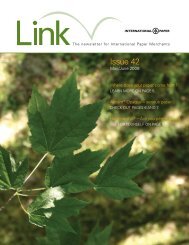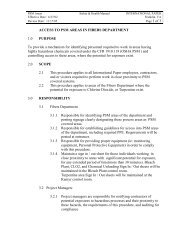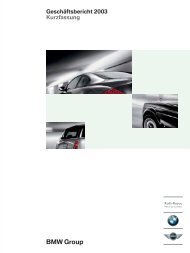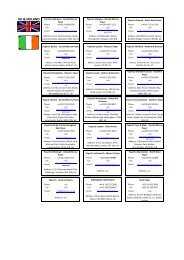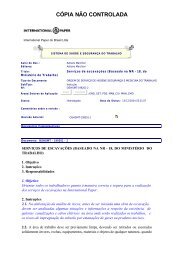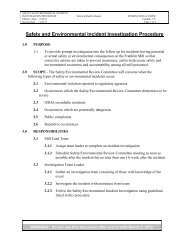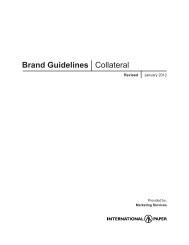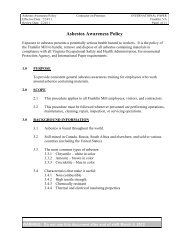Frequently Asked Questions about PEFC - International Paper
Frequently Asked Questions about PEFC - International Paper
Frequently Asked Questions about PEFC - International Paper
You also want an ePaper? Increase the reach of your titles
YUMPU automatically turns print PDFs into web optimized ePapers that Google loves.
<strong>PEFC</strong>/10-31-179<br />
www.ipaper.com/europe<br />
This brochure is printed on IP Pro-Design, <strong>PEFC</strong> certified paper
<strong>PEFC</strong>/10-31-179<br />
Sustainable<br />
forest management<br />
All you need to know
Table of contents<br />
1. What is meant by “sustainable forest management”? 4<br />
2. What is <strong>International</strong> <strong>Paper</strong>’s commitment to sustainable forest management? 4<br />
3. What is forest certification? 5<br />
4. What is the <strong>PEFC</strong>? 5<br />
5. How does <strong>PEFC</strong> operate? 6<br />
6. How does a forest get certified and how is certification renewed? 6<br />
7. What is a “chain of custody” certificate? 7<br />
8. What are the two ways wood origin is traced? 8<br />
9. What are the different labelling options for certified products in <strong>PEFC</strong>? 9<br />
10. How does <strong>PEFC</strong> certification ensure that raw material doesn’t come from a protected forest? 10<br />
11. What are the industry benefits of <strong>PEFC</strong> forest and chain of custody certification? 11<br />
12. Is <strong>International</strong> <strong>Paper</strong> certified? Or is the paper certified? 13<br />
13. What organisation does <strong>PEFC</strong> represent? 13<br />
14. In what countries are <strong>PEFC</strong>-certified forests or business located? 14<br />
15. How much forest is included in <strong>PEFC</strong> certification schemes? 16<br />
16. If a distributor wants to show that its products are <strong>PEFC</strong>-certified, can it use the <strong>PEFC</strong> logo? 18<br />
17. What products besides paper are certified <strong>PEFC</strong>? 19<br />
18. What are the unique selling points of <strong>PEFC</strong>? 20<br />
19. Does <strong>PEFC</strong> certification also cover recycled wood-based material? 21<br />
20. Which <strong>International</strong> <strong>Paper</strong> plants in Europe use wood or pulp from <strong>PEFC</strong>-certified forests? 22<br />
21. What is the link between <strong>PEFC</strong>/SFI and CERFLOR? 23<br />
22. What other environmental benefits do certified forests provide? 23<br />
1
Introduction<br />
In today’s environmentally conscious world, consumers want to know that the paper and<br />
wood products they buy come from sustainably managed forests that will remain healthy<br />
and able to meet the needs of future generations.<br />
<strong>International</strong> <strong>Paper</strong> answers this demand by having the sustainability of our forest management<br />
practices certified by independent third parties. We do this through the <strong>PEFC</strong><br />
certification system, an initiative supported by a wide range of international groups.<br />
Two-thirds of all certified forests globally have been endorsed by <strong>PEFC</strong>, making it the<br />
world’s largest resource of certified wood. Its recognition in government and private procurement<br />
is growing rapidly.<br />
Increasing numbers of paper and timber trading and processing sector companies have<br />
chosen <strong>PEFC</strong> as their efficient and reliable tool for the safe sourcing of raw materials and<br />
products.<br />
This booklet contains answers to commonly asked questions <strong>about</strong> <strong>PEFC</strong> and <strong>International</strong><br />
<strong>Paper</strong>’s engagement with sustainably managed forest certification. We hope it will be a<br />
useful source of information in your discussion with customers.<br />
If you have any additional questions, please contact Patricia LaRocca<br />
(patricia.larocca@ipaper.com) and we will do our best to answer them.<br />
<strong>Questions</strong> & Answers<br />
2
1What is meant by “sustainable forest management”?<br />
This term means the sustained economic and social development of resources without compromising<br />
the needs of future generations. Sustainable forestry practices take into account:<br />
• the balance between growth and removals<br />
• cultural values<br />
• biodiversity<br />
• protective functions of forests<br />
• forest health and vitality<br />
• forest resources and global carbon cycles<br />
2What is <strong>International</strong> <strong>Paper</strong>’s commitment<br />
to sustainable forest management?<br />
Sustainability is at the core of our operating philosophy. It is a business practice that is at the absolute<br />
core of the way we manage for today and the future.<br />
We also ensure our forests will support clean air and water, diverse wildlife habitat,<br />
recreational opportunities and aesthetic beauty.<br />
3<br />
<strong>Questions</strong> & Answers
3What is forest certification?<br />
4What is the <strong>PEFC</strong>?<br />
<strong>PEFC</strong>/10-31-179<br />
This is the mechanism using third party certification bodies to provide assurance that a forest<br />
is managed according to internationally recognised sustainability criteria.<br />
In this voluntary, market-based approach, a forest’s management and operations are rigorously audited<br />
by an independent, accredited organisation.<br />
The certification process is carried out within the framework of a recognised forest certification scheme.<br />
<strong>PEFC</strong> stands for Programme for the Endorsement of Forest Certification Schemes. The <strong>PEFC</strong> is an<br />
independent, non-profit, non-governmental organisation.<br />
<strong>PEFC</strong> principle missions<br />
• Promoting sustainable forest management through independent third-party certification<br />
• Providing an assurance mechanism so purchasers of wood and paper products can be sure they<br />
are supporting sustainable forestry<br />
• Strengthening the positive image of forestry and wood as a renewable raw material<br />
4
5How does <strong>PEFC</strong> operate?<br />
<strong>PEFC</strong> operates by endorsing national forest certification programmes. The national scheme must<br />
be developed in an open and transparent way through a multi-stakeholder process. It is then assessed<br />
by independent consultants to make sure it meets <strong>PEFC</strong> requirements for standard-setting, sustainable<br />
forest management, chain of custody and certification bodies.<br />
Finally, all <strong>PEFC</strong> national forest certification schemes vote to mutually recognise the applicant scheme<br />
or not. This requires a 2/3 majority, and only recognised national schemes can use the <strong>PEFC</strong> logo.<br />
The schemes are reviewed at least every five years.<br />
6How does a forest get certified and<br />
how is certification renewed?<br />
In order to obtain the certificate, a full audit of a forest’s management procedures is carried out.<br />
The certificate is valid for up to 5 years and surveillance audits are carried out annually.<br />
5<br />
<strong>Questions</strong> & Answers
7What is a “chain of custody” certificate?<br />
Chain of custody (CoC) is a tracing system used throughout all steps of wood and pulp manufacturing<br />
and distribution. The CoC provides confidence to customers that the company’s claim of a certified<br />
product is truthful.<br />
A CoC certificate is issued by an independent, accredited certification body which verifies that the<br />
wood flow accounting system of an enterprise meets the exact requirements of the certification scheme.<br />
A CoC certificate is valid for up to five years but surveillance audits are carried out annually.
8What are the two ways wood origin is traced?<br />
In a chain of custody, the wood’s origin is traced and the certified content is calculated in two<br />
different ways: through the percentage model or through physical separation. For papermaking,<br />
the percentage model is generally used.<br />
Through physical separation The percentage model<br />
Using the physical separation of wood, each batch<br />
from certified forests must be kept physically separate<br />
from all other wood at every stage from harvesting and<br />
transport to intermediate storage and processing.<br />
7<br />
Using the percentage model, the enterprise may label the<br />
proportion of its production that corresponds to the amount of raw<br />
material used from certified sources. The implementation of this is<br />
verified by inventory records at each stage of the process. Once an<br />
enterprise achieves over 70% input from certified sources, it can<br />
label all of its production with a <strong>PEFC</strong> logo.<br />
<strong>Questions</strong> & Answers
9What are the different labelling options<br />
for certified products in <strong>PEFC</strong>?<br />
A company may label its products with a <strong>PEFC</strong> logo once the <strong>PEFC</strong>-certified content exceeds 70%.<br />
This is verified by inventory records at each stage of the process. The <strong>PEFC</strong> logo on the products can<br />
be accompanied by different claims:<br />
a. “From sustainably managed forests – For more info: www.pefc.org” in cases where the wood<br />
comes from forests and suppliers that used the physical separation model in all previous stages of the<br />
chain, and the certified wood content is 100%.<br />
b. “Promoting sustainable forest management – For more info: www.pefc.org” in cases where the<br />
chain of custody certification is based on the percentage model or physical separation (where the<br />
conditions for “a” have not been met), and the certified wood content is at least 70%.<br />
c. “Promoting sustainable forest management and recycling - For more info: www.pefc.org” in cases<br />
where the certified product includes <strong>PEFC</strong> recycled raw material, and certified and recycled material<br />
add up to at least 70%. The <strong>PEFC</strong> logo in this case has to be accompanied by the Möbius loop and<br />
the percentage of recycled material has to be stated inside the Möbius loop.<br />
8
10<br />
How does <strong>PEFC</strong> certification ensure that<br />
raw material doesn’t come from a protected forest?<br />
<strong>PEFC</strong> requires that no wood from controversial sources (e.g. illegal logging or strictly protected areas)<br />
may enter the certified product chain.<br />
CoC-certified companies are obliged to obtain a signed self-declaration from all suppliers of uncertified<br />
material that no wood is derived from these sources.<br />
9<br />
CoC certified companies need to undertake risk analyses for<br />
uncertified wood. If a high risk exists that raw material originates<br />
from controversial sources, CoC-certified companies must put in<br />
place safety checks such as external assessments, second/third party<br />
verification mechanisms and on-site inspections, to ensure the legality<br />
of the uncertified wood.<br />
<strong>Questions</strong> & Answers
11 What are the industry benefits of <strong>PEFC</strong> forest<br />
and chain of custody certification?<br />
Certified tracking of the wood flow offers a number of business bonuses to the wood-processing industry<br />
and business-to-business suppliers, as well as customers, retailers and traders.<br />
• Improving market access, as increasing numbers of customers, retailers and<br />
traders specify wood from certified sources only<br />
• Demonstrating their commitment to sustainable development<br />
• Creating a wood flow accounting system to improve business efficiency<br />
• Improving the image of the wood-processing sector<br />
• Promoting wood and competing more successfully with other materials<br />
10
11<br />
<strong>Questions</strong> & Answers
12<br />
Is <strong>International</strong> <strong>Paper</strong> certified?<br />
Or is the paper certified?<br />
A manufacturing or distribution facility can be holder of a CoC certification. However this does not<br />
mean that (all) its products are (100%) certified. The CoC certificate guarantees that the company has<br />
assurance mechanisms in place to trace certified products in the company’s production process.<br />
The product certification is the customer’s guarantee that the paper is made from pulp from certified<br />
forests. For example, <strong>International</strong> <strong>Paper</strong>’s Rey, IP Pro, IP Preprint and JetSet Colour product ranges are<br />
made of <strong>PEFC</strong> certified fibres. Please check our website for the latest list of certified products.<br />
13<br />
What organisations does <strong>PEFC</strong> represent?<br />
Founded in 1999, the <strong>PEFC</strong> represents a wide range of bodies<br />
with interests in sustainable forest management. These include:<br />
• forest owners and managers<br />
• forest industry/processors<br />
• trade unions<br />
• traders/buyers<br />
• government public institutions<br />
• forest science<br />
• indigenous/local communities<br />
• consumers<br />
• other forest users (e.g. recreation)<br />
12
14<br />
In what countries are <strong>PEFC</strong>-certified forests<br />
or businesses located?<br />
<strong>PEFC</strong> members include more than 35 independent national forest certification schemes. Of these,<br />
more than 23 have already been through a rigorous assessment by independent consultants. The other<br />
national members’ schemes are working towards <strong>PEFC</strong> endorsement. Only endorsed schemes can use<br />
the <strong>PEFC</strong> logo or claim their forests to be <strong>PEFC</strong> certified.<br />
<strong>PEFC</strong> Members<br />
The members are national organisations representing the various stakeholder groups in a country, such<br />
as forest owners, environmental groups, paper industries and trade unions.<br />
For the latest information on endorsed forest certification schemes see www.pefc.org. All forest certification<br />
systems that have been endorsed by <strong>PEFC</strong> are marked with a tick (¸) on the website www.pefc.<br />
org > <strong>PEFC</strong> members & schemes.<br />
13<br />
<strong>Questions</strong> & Answers
<strong>PEFC</strong> endorsed systems<br />
<strong>PEFC</strong> member systems<br />
not endorsed yet<br />
14<br />
This map is subject to changes – please see www.pefc.org<br />
for the latest information.
15<br />
How much forest is included in <strong>PEFC</strong> certification schemes?<br />
68%<br />
<strong>PEFC</strong> endorsed systems<br />
Currently, there are <strong>about</strong> 200 million hectares (<strong>about</strong> 500 million acres) of <strong>PEFC</strong>-certified forests<br />
producing millions of tonnes of certified timber. This makes <strong>PEFC</strong> the world’s largest certification<br />
scheme. Moreover, the majority of European forests are <strong>PEFC</strong>-certified.<br />
15<br />
31%<br />
Others<br />
<strong>Questions</strong> & Answers
16<br />
If a distributor wants to show that its products<br />
are <strong>PEFC</strong>-certified, can it use the <strong>PEFC</strong> logo?<br />
The <strong>PEFC</strong> logo is a communication tool that certified companies can use on their certified timber,<br />
paper and wood-based products to inform customers and final consumers <strong>about</strong> the origin of the raw<br />
material.<br />
The <strong>PEFC</strong> logo can be used on- or off-product (e.g. sales tools, etc.) under license from <strong>PEFC</strong>. Users<br />
must have a valid forest management certificate or chain of custody certificate.<br />
The license number must be used together with the logo. A public online database at www.pefc.org<br />
provides information on all certificates or logo license numbers for each forest or chain of custody<br />
certificate in every <strong>PEFC</strong> national scheme.<br />
17<br />
<strong>Questions</strong> & Answers
17<br />
What products besides paper are certified <strong>PEFC</strong>?<br />
Any forest-based product – including lumber, wood-based building materials and furniture – can be<br />
<strong>PEFC</strong>-certified as long as it is made with raw material from a certified forest. The seller must also have<br />
a chain of custody certificate verifying the origin of the raw material.<br />
18
18 What are the unique selling points of <strong>PEFC</strong>?<br />
<strong>PEFC</strong> is fully recognised by many governments around the world as a guarantee of sustainable forest<br />
management. Supported by all players in the wood and paper sector, it is the industry standard.<br />
In 2006 the European Parliament passed a resolution in which it recognised <strong>PEFC</strong> as a means to assure<br />
consumers <strong>about</strong> sustainable forest management.<br />
<strong>PEFC</strong> has the simplest labelling system: a single label guaranteeing that at least 70% of the raw material<br />
comes from a certified forest.<br />
<strong>PEFC</strong> sets the highest minimum requirements in terms of certified wood content for labelling<br />
purposes. The minimum threshold is 70%.<br />
<strong>PEFC</strong> is the largest forest certification scheme worldwide. Moreover, the majority<br />
of European forests are <strong>PEFC</strong>-certified.<br />
19<br />
<strong>Questions</strong> & Answers
250<br />
200<br />
150<br />
100<br />
50<br />
<strong>PEFC</strong> certified Companies<br />
Mill. Hectares<br />
32,38 41,06 46,10 50,86<br />
55,32<br />
187,68 193,81 194,38<br />
0 1999 2000 2001 2002 2003 2004 2005 2006 2007<br />
Number of Chain of Custody certificates<br />
19<br />
Does <strong>PEFC</strong> certification also cover recycled<br />
wood-based material?<br />
4000<br />
3500<br />
3000<br />
2500<br />
2000<br />
1500<br />
1000<br />
500<br />
0 1999 2000 2001 2002 2003 2004 2005 2006 2007<br />
In July 2005, <strong>PEFC</strong> introduced a new option allowing companies to communicate the content of<br />
recycled raw material in their products by using a combined label containing the <strong>PEFC</strong> logo and the<br />
Möbius loop.<br />
The new label can be used on products where the total content of <strong>PEFC</strong>-certified wood or fibres and<br />
<strong>PEFC</strong> recycled raw material exceeds 70%. The percentage of the recycled material has to be stated<br />
inside the Möbius loop.<br />
20<br />
108<br />
424<br />
1100<br />
1905<br />
2362<br />
2901<br />
3545
20<br />
Which <strong>International</strong> <strong>Paper</strong> plants in Europe<br />
use wood or pulp from <strong>PEFC</strong>-certified forests?<br />
Saillat, France<br />
About 45% of wood is from local <strong>PEFC</strong>-certified forests. This percentage is growing rapidly.<br />
Kwidzyn, Poland<br />
Over 80% of wood is from Polish State Forests. The endorsement of the Polish <strong>PEFC</strong> has been<br />
approved in March 2008.<br />
Svetogorsk, Russia<br />
The two national forest certification initiatives in Russia are members of the <strong>PEFC</strong> and have announced<br />
their intention to apply to international <strong>PEFC</strong> endorsement.<br />
Inverurie, Scotland<br />
About 90% of pulp is supplied by <strong>PEFC</strong> and SFI or CERFLOR certified forests.<br />
21<br />
<strong>Questions</strong> & Answers
21<br />
What is the link between <strong>PEFC</strong>/SFI and CERFLOR?<br />
In December 2005, <strong>PEFC</strong> officially endorsed the North American Sustainable Forestry Initiative<br />
(SFI) certification system, a programme that is actively promoted by <strong>International</strong> <strong>Paper</strong> in the USA.<br />
CERFLOR, the Brazilian forest certification programme, was endorsed by the <strong>PEFC</strong> Council<br />
in October 2005.<br />
22<br />
What other environmental benefits do<br />
certified forests provide?<br />
Sustainable forest practices help to fight global warming by preventing deforestation and by replanting<br />
trees in the certified forests. Managed forests constantly absorb carbon dioxide from the atmosphere.<br />
This captured CO2 is eventually bound up in the timber and paper products.<br />
22



